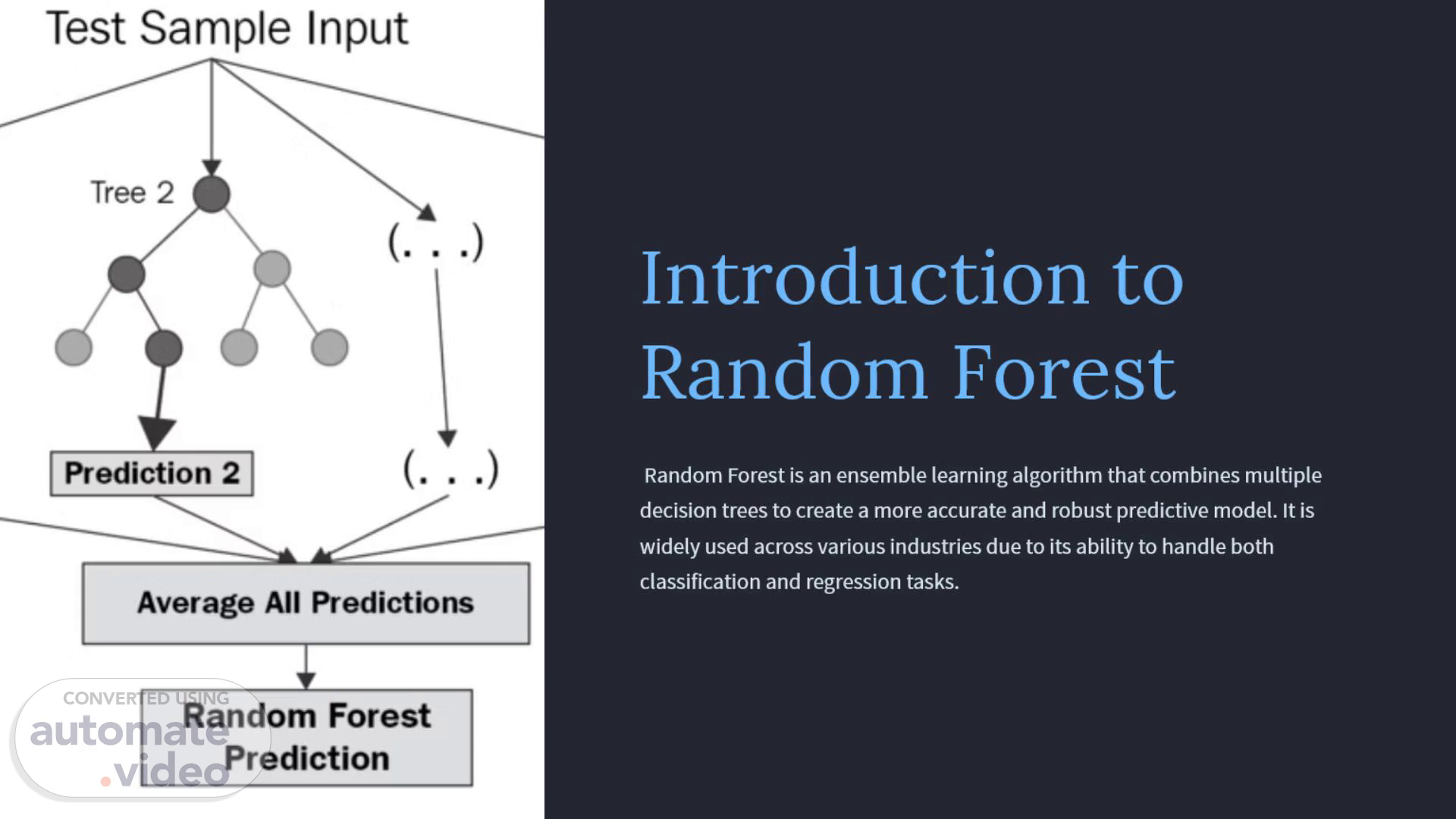
PptxGenJS Presentation
Scene 1 (0s)
[Audio] Introduction to Random Forest Random Forest is an ensemble learning algorithm that combines multiple decision trees to create a more accurate and robust predictive model. It is widely used across various industries due to its ability to handle both classification and regression tasks..
Scene 2 (22s)
[Audio] Applications in Healthcare Disease Diagnosis Drug Discovery Patient Risk Stratification Random Forest models can analyze complex medical data to accurately diagnose diseases, helping healthcare professionals provide better patient care. The algorithm can identify promising drug candidates by evaluating large chemical compound libraries and predicting their therapeutic potential. Random Forest can assess patient risk factors and predict the likelihood of adverse outcomes, enabling personalized treatment plans..
Scene 3 (56s)
[Audio] Applications in Finance Credit Risk Modeling Fraud Detection Random Forest can assess the creditworthiness of loan applicants, helping lenders make more informed decisions and reduce default rates. The algorithm can identify suspicious financial transactions by analyzing patterns in large datasets, protecting against fraudulent activities. Stock Price Prediction Random Forest models can analyze market trends and historical data to forecast stock prices, assisting investors in making informed trading decisions..
Scene 4 (1m 32s)
[Audio] Applications in Retail Customer Segmentation Inventory Optimization Random Forest can analyze customer behavior and demographics to create targeted marketing campaigns and personalize the shopping experience. The algorithm can predict demand and sales patterns, helping retailers optimize their inventory levels and reduce wastage. Recommendation Systems Random Forest models can analyze customer preferences and purchase history to provide personalized product recommendations, increasing sales and customer loyalty..
Scene 5 (2m 4s)
[Audio] Applications in Cybersecurity Intrusion Detection Malware Analysis User Behavior Analytics Random Forest can identify suspicious network activity and detect potential cyber threats, protecting organizations from data breaches and cyberattacks. The algorithm can analyze file behavior and characteristics to accurately classify and detect malicious software, safeguarding systems and networks. Random Forest models can monitor and analyze user activities to identify anomalies and insider threats, enhancing overall cybersecurity measures..
Scene 6 (2m 39s)
[Audio] Applications in Environmental Science Climate Modeling Habitat Mapping Pollution Monitoring Random Forest can analyze large datasets of climate variables to predict weather patterns and model the impact of climate change. The algorithm can classify and map different ecosystems and habitats based on remote sensing data, supporting conservation efforts. Random Forest models can detect and predict pollution levels by integrating data from various sensors and environmental monitoring systems..
Scene 7 (3m 12s)
[Audio] Applications in Social Sciences Voting Behavior Analysis Random Forest can predict voter turnout and voting patterns based on demographic, socioeconomic, and political factors, helping policymakers and campaigns make informed decisions. Sentiment Analysis The algorithm can analyze large volumes of text data, such as social media posts and survey responses, to identify trends and patterns in public sentiment. Crime Prediction Random Forest models can leverage crime data, socioeconomic factors, and geographic information to predict the likelihood of criminal activity, aiding in the development of effective crime prevention strategies..
Scene 8 (3m 53s)
[Audio] Conclusion and Key Takeaways Versatile Algorithm Random Forest is a highly versatile algorithm that can be applied to a wide range of classification and regression tasks across diverse industries and domains. Robust Performance The ensemble nature of Random Forest makes it resistant to overfitting and able to handle noisy or incomplete data, resulting in accurate and reliable predictions. Interpretability Random Forest models are relatively easy to interpret, as they provide insights into the relative importance of different features in the decision-making process..